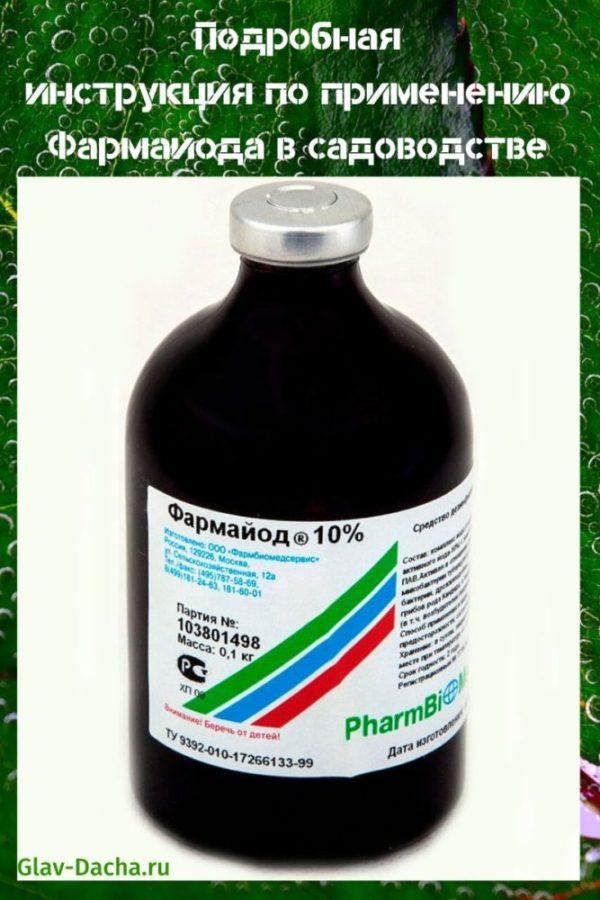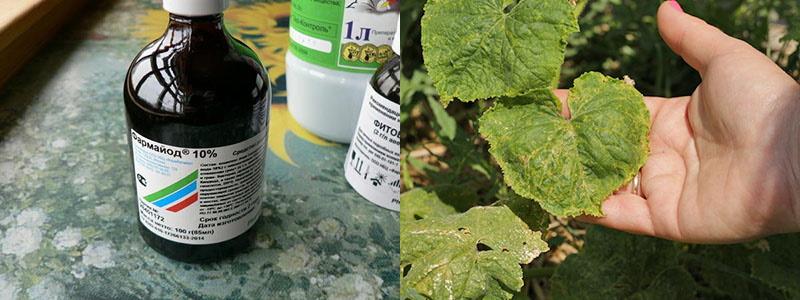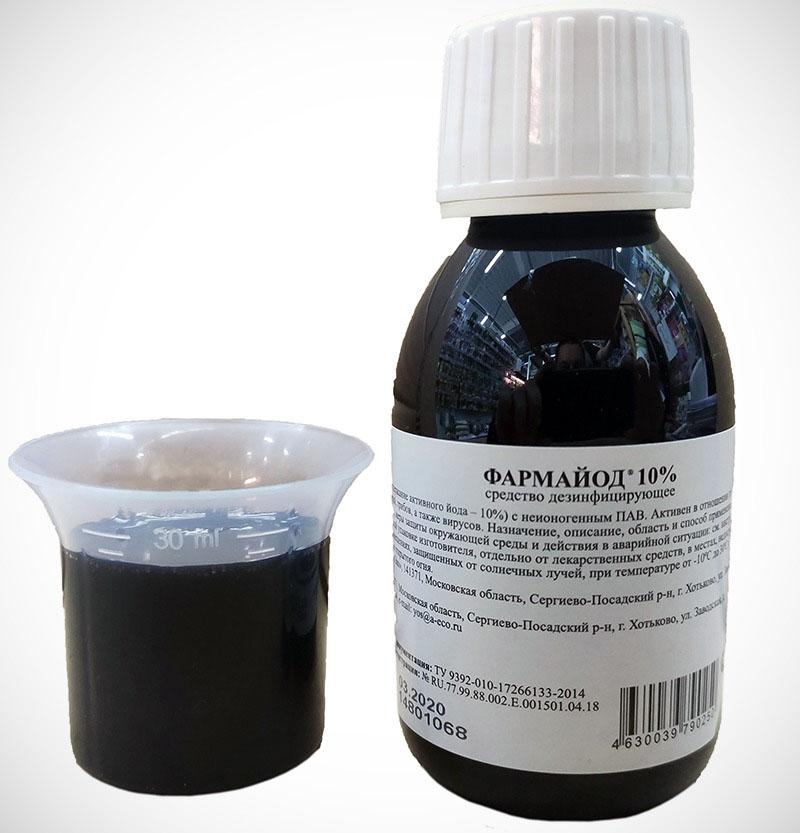Detailed instructions for the use of Farmayod in gardening
 The presence of pathogens of dangerous diseases and pests in the summer cottage gives the farmer a lot of trouble. You cannot do without pesticides in the garden, and the instructions for the use of Farmayod will become a reliable guide in this unofficial struggle. A concentrated agent is used to treat both planting material and soil, and working tools. This prudence will help the gardener to maximally protect their land from "annoying guests".
The presence of pathogens of dangerous diseases and pests in the summer cottage gives the farmer a lot of trouble. You cannot do without pesticides in the garden, and the instructions for the use of Farmayod will become a reliable guide in this unofficial struggle. A concentrated agent is used to treat both planting material and soil, and working tools. This prudence will help the gardener to maximally protect their land from "annoying guests".
Antiseptic drug close up
 Pure iodine acts as the active substance of the biocide. The content of the element in the alcohol solution is 10%. Also, Pharmoiod contains non-ionic surfactants. The peculiarity of these chemical compounds is that they dissolve in water, but do not form ions. Active components disrupt the vital activity of pathogens at all stages of development, destroying cell membranes.
Pure iodine acts as the active substance of the biocide. The content of the element in the alcohol solution is 10%. Also, Pharmoiod contains non-ionic surfactants. The peculiarity of these chemical compounds is that they dissolve in water, but do not form ions. Active components disrupt the vital activity of pathogens at all stages of development, destroying cell membranes.
Therefore, in horticulture, Farmayod is widely used to combat:
- infections;
- viruses;
- lichens;
- fungi (also yeast-like);
- mold;
- parasites.
Remarkably, the biocide has an active effect on gram-positive and gram-negative bacteria. These types of pathogens include mycobacterium tuberculosis, all types of hepatitis and HIV.
 Upon contact with soil or any surface, the product completely destroys pathogenic microflora. Still, it is worth remembering that the chemical composition also eliminates beneficial microorganisms. Such etching is somewhat similar to the effect of chemotherapy on the human body. In this regard, it is important to comply with all requirements and dosages specified in the Pharmayod instructions for use. The prepared solution also removes minerals from the soil.
Upon contact with soil or any surface, the product completely destroys pathogenic microflora. Still, it is worth remembering that the chemical composition also eliminates beneficial microorganisms. Such etching is somewhat similar to the effect of chemotherapy on the human body. In this regard, it is important to comply with all requirements and dosages specified in the Pharmayod instructions for use. The prepared solution also removes minerals from the soil.
To restore the proper microflora, the following must be added to the land plot:
- humates;
- complex fertilizers;
- broad spectrum biological products.
Iodized solution has a dark brown tint. Manufacturers release the concentrate in various volumes: 85 ml (bottle), 850 ml and 5 liters (canister).
With regular use of the antiseptic tincture, many gardeners have observed a positive side effect. The number of insect pests (thrips, mites and nematodes) significantly decreased in the cultivated area.
The effect of the drug as a fungicidal agent is enhanced when the temperature is raised to + 25˚С.
Storage is an important aspect
 The biocide is stored only in its original packaging, with the lid sealed. They choose a place inaccessible to children, as well as away from medications. The storage area must be well ventilated and without access to direct sunlight. Temperature conditions are allowed within -10 ... + 30˚С with minimum humidity. The shelf life of the biocide under such conditions is 2 years.
The biocide is stored only in its original packaging, with the lid sealed. They choose a place inaccessible to children, as well as away from medications. The storage area must be well ventilated and without access to direct sunlight. Temperature conditions are allowed within -10 ... + 30˚С with minimum humidity. The shelf life of the biocide under such conditions is 2 years.
The disinfectant contains a high percentage of alcohol and is therefore kept away from heating objects and open flames.
At low temperatures, the concentrate can solidify. A simple procedure will help to return the jelly-like mass to working condition. For this, the bottle is transferred to a warm room. Some of them are heated in a water bath or in another way.
Instructions for the use of Farmayod against viral diseases
The working solution is prepared strictly in accordance with the suggested dosages. Besides, in  without fail observe the consumption rates of the prepared liquid. In some cases, iodized concentrate is combined with Fitolavin. Processing is carried out during the growing season of crops. After such therapy, after 3-6 days, colonies of live bacteria are applied to the surface. To do this, use drugs Baikal EM1 or Shine.
without fail observe the consumption rates of the prepared liquid. In some cases, iodized concentrate is combined with Fitolavin. Processing is carried out during the growing season of crops. After such therapy, after 3-6 days, colonies of live bacteria are applied to the surface. To do this, use drugs Baikal EM1 or Shine.
Many are interested in whether iodine can be used instead of Pharmayod. It is almost impossible to replace the biocide, since it contains non-ionic surfactants.
For tomatoes and cucumbers
 Iodized tincture is effective in combating many types of mosaics (cucumber, green speckled and tomatoes), as well as with complex streaks. Therefore, a working solution is used to treat tomato and cucumber seeds. 1 ml of the preparation is measured with a syringe. Then it is diluted in 200 ml of water. The planting material is soaked in the resulting emulsion for 30 minutes.
Iodized tincture is effective in combating many types of mosaics (cucumber, green speckled and tomatoes), as well as with complex streaks. Therefore, a working solution is used to treat tomato and cucumber seeds. 1 ml of the preparation is measured with a syringe. Then it is diluted in 200 ml of water. The planting material is soaked in the resulting emulsion for 30 minutes.
The use of Farmayod on tomatoes is carried out in three phases of culture development:
- 5-7 true leaves;
- period of budding, as well as flowering;
- when fruits appear.
The preparation of the working solution takes place taking into account the dosage: 5 ml of the product per 10 liters of liquid. The resulting composition is practiced to water the planting during fruiting, increasing the dosage to 10 ml. In addition, 200-400 ml of the prepared solution can be applied under the root of each plant. Some organize drip irrigation.
After spraying the seedlings, immunostimulating compositions are additionally used. For example, many people choose the drug HB-101.
 When growing cucumbers, seeds are processed in the same way. Spraying of seedlings is allowed when 2-4 leaves appear. To process the planting, a different dosage of the biocide is needed - 3 ml / 10 l. Root watering is carried out unchanged.
When growing cucumbers, seeds are processed in the same way. Spraying of seedlings is allowed when 2-4 leaves appear. To process the planting, a different dosage of the biocide is needed - 3 ml / 10 l. Root watering is carried out unchanged.
Fruit and stone fruit crops, as well as potatoes
 Lichens, fungal infections, and saprotrophic fungi often appear on the bark. At the same time, fruit trees often infect viral and bacterial infections. Therefore, when performing spring pruning, cuts and cuts must be processed with Farmayod. For this, only a 0.5-1% solution is used. In 10 liters of water, 50-100 ml of concentrate is diluted, taking into account the degree of plant infestation. In all other cases, the dosage is 10 ml / 10 l.
Lichens, fungal infections, and saprotrophic fungi often appear on the bark. At the same time, fruit trees often infect viral and bacterial infections. Therefore, when performing spring pruning, cuts and cuts must be processed with Farmayod. For this, only a 0.5-1% solution is used. In 10 liters of water, 50-100 ml of concentrate is diluted, taking into account the degree of plant infestation. In all other cases, the dosage is 10 ml / 10 l.
The procedure is performed when:
- the formation of a green cone;
- the appearance of a pink bud;
- ovary formation;
- ripening of fruits;
- falling leaves.

Spraying in the budding and cone formation stage is performed using a less concentrated liquid. So, only 5 ml of the product is added to 10 liters of water.
When growing potatoes, treatment is planned for the period of budding or flowering. The consumption rate of iodized alcoholic tincture is 3-5 ml / 10 l. During this time, up to 2-3 treatments are carried out. An interval of 10 days is observed between them. To reduce the aggressive effect of the drug, immunostimulants are additionally introduced.
Instructions for the use of Farmayod for soil disinfection
 The correct way of using Pharmayod will reduce the number of pathogenic colonies by almost 98%.
The correct way of using Pharmayod will reduce the number of pathogenic colonies by almost 98%.
For a successful procedure, the manufacturer's recommendations are always followed:
- 100 ml of concentrate is diluted in 10 liters of water;
- with a strong or massive infection, the dosage is increased to 300 ml (the volume is retained);
- the consumption rate of the working solution is 10 liters per 5 m².
 The area is watered with the prepared emulsion moderately enough, but without frills. In this case, use a regular watering can with a strainer.
The area is watered with the prepared emulsion moderately enough, but without frills. In this case, use a regular watering can with a strainer.
Planting crops is advised to be carried out only after 48 hours have passed since the treatment of the site.
Processing of greenhouses and warehouses (storage facilities)
 During the season, a lot of pathogens of viral infections accumulate on the walls (film) and glass of greenhouse structures. Therefore, all surfaces of the greenhouse / greenhouse are sprayed or wiped with the prepared working fluid. The rate of application of the drug is 100 ml per 10 liters of water.
During the season, a lot of pathogens of viral infections accumulate on the walls (film) and glass of greenhouse structures. Therefore, all surfaces of the greenhouse / greenhouse are sprayed or wiped with the prepared working fluid. The rate of application of the drug is 100 ml per 10 liters of water.
Often, a lot of dust settles in such structures, as well as plaque or greasy spots appear. Then, before the start of disinfection, they perform wet cleaning of those tiles.
 Vegetables and fruits are stored in special warehouses. They can also serve as breeding grounds for harmful microorganisms. Therefore, they are also disinfected with a biocide solution. For 10 liters of water, take up to 10 ml of iodized agent.
Vegetables and fruits are stored in special warehouses. They can also serve as breeding grounds for harmful microorganisms. Therefore, they are also disinfected with a biocide solution. For 10 liters of water, take up to 10 ml of iodized agent.
Here is a complete list of recommendations specified in the Pharmayod instructions for use. However, before disinfection, it is worthwhile to read the package insert, since each manufacturer can offer their own version of the use of the drug.